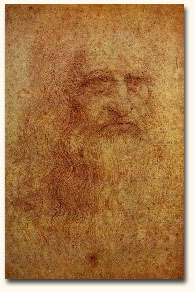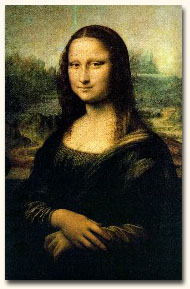
by
Will Durant
 On and off, during the years 1503-6,
Leonardo Da Vinci painted the portrait of Mona Lisa
-- i.e., Madonna Elisabetta, third wife of Francesco
del Giocondo, who in 1512 was to be a member of the
Signory.
On and off, during the years 1503-6,
Leonardo Da Vinci painted the portrait of Mona Lisa
-- i.e., Madonna Elisabetta, third wife of Francesco
del Giocondo, who in 1512 was to be a member of the
Signory.
Presumably a child of
Francesco, buried in 1499, was one of Elisabetta's
children, and this loss may have helped to mold the
serious features behind La Gioconda's smile. That
Leonardo should call her back to his studio so many
times during those three years; that he should spend
upon her portrait all the secrets and nuances of his
art -- modeling her softly with light and shade,
framing her in a fanciful vista of trees and waters,
mountains and sky -- clothing her in raiment of
velvet and satin woven into folds whose every wrinkle
is a masterpiece -- studying with passionate care the
subtle muscles that form and move the mouth --
bringing musicians to play for her and to evoke upon
her features the disillusioned tenderness of a mother
remembering a departed child: these are inklings of
the spirit in which he came to this engaging merger
of painting and philosophy. A thousand interruptions,
a hundred distracting interests, the simultaneous
struggle with the Anghiari design, left unbroken the
unity of his conception, the unwonted pertinacity of
his zeal.
This, then, is the
face that launched a thousand reams upon a sea of
ink. Not an unusually lovely face; a shorter nose
would have launched more reams; and many a lass in
oil or marble -- as in any Correggio -- would by
comparison make Lisa only moderately fair. It is her
smile that has made her fortune through the centuries
-- a nascent twinkle in her eyes, an amused and
checked upcurving of her lips.
 What is she smiling at? The efforts of
the musicians to entertain her? The leisurely
diligence of an artist who paints her through a
thousand days and never makes an end? Or is it not
just Mona Lisa smiling, but women, saying to all men:
"Poor impassioned lovers! A Nature blindly
commanding continuance burns your nerves with an
absurd hunger for our flesh, softens your brains with
a quite unreasonable idealization of our charms,
lifts you to lyrics that subside with consummation --
and all that you may be precipitated into parentage!
Could anything be more ridiculous? But we too are
snared; we women pay a heavier price than you for
your infatuation. And yet, sweet fools, it is
pleasant to be desired, and life is redeemed when we
are loved."
What is she smiling at? The efforts of
the musicians to entertain her? The leisurely
diligence of an artist who paints her through a
thousand days and never makes an end? Or is it not
just Mona Lisa smiling, but women, saying to all men:
"Poor impassioned lovers! A Nature blindly
commanding continuance burns your nerves with an
absurd hunger for our flesh, softens your brains with
a quite unreasonable idealization of our charms,
lifts you to lyrics that subside with consummation --
and all that you may be precipitated into parentage!
Could anything be more ridiculous? But we too are
snared; we women pay a heavier price than you for
your infatuation. And yet, sweet fools, it is
pleasant to be desired, and life is redeemed when we
are loved."
Or was it only the
smile of Leonardo himself that Lisa wore -- of the
inverted spirit that could hardly recall the tender
touch of a woman's hand, and could believe in no
other destiny for love or genius than obscene
decomposition, and a little fame flickering out in
man's forgetfulness?
When at last the
sittings ended, Leonardo kept the picture, claiming
that this most finished of all portraits was still
incomplete. Perhaps the husband did not like the
prospect of having his wife curl up her lips at him
and his guests, hour after hour from his walls. Many
years later, Francis I bought it for 4,000 crowns
($50,000), and framed it in his palace at
Fontainebleau. Today, after some time and
restorations have blurred its subtleties, it hangs in
the majestic Salon Carre of the Louvre, daily amused
by a thousand worshippers, and waiting for time to
efface and confirm Mona Lisa's smile.
.